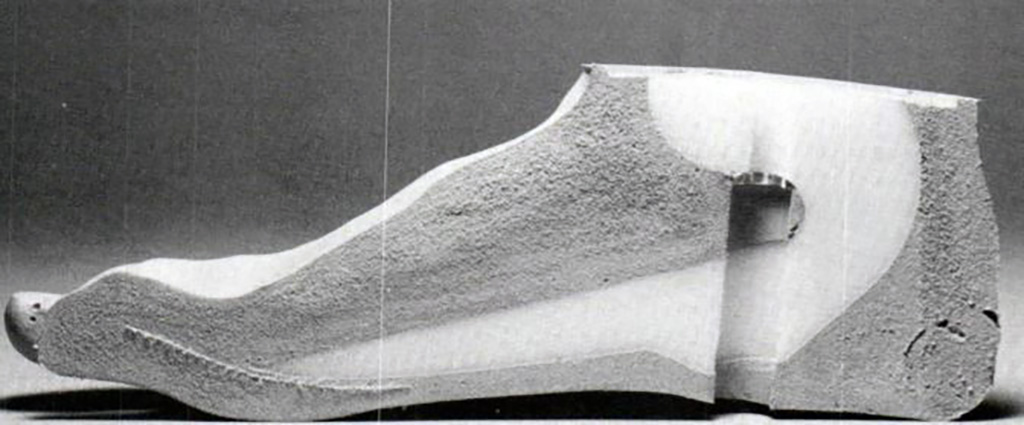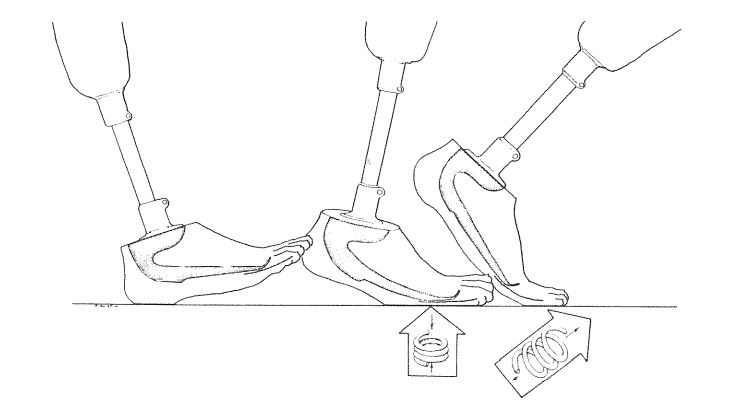
Among VA’s many achievements in the research and design of prosthetic limbs, the Seattle Foot ranks as one of the most revolutionary. Prior to its development in the early 1980s, lower limb amputees using a prosthetic foot were able to stand and walk on flat surfaces but most could not run or even stride quickly. Existing prostheses did not provide a natural spring or bounce necessary for a smooth, comfortable gait when attempting rapid movement, resulting in what patients termed the “dead effect.” The Seattle Foot solved this issue with its simple yet innovative design built around a flexible light-weight keel made from synthetic material that served as a spring, propelling the individual forward.
The Seattle Foot emerged from a five-year study conducted by the Prosthetics Research Study (PRS) at the Seattle VA Medical Center in partnership with research kinesiologists at the University of Washington. Dr. Ernest M. Burgess, the director of PRS and a pioneer in the field of prosthetic medicine, spearheaded the investigation. Engineers from Boeing assisted with the manufacturing of the artificial foot, which consisted of just three components: the internal keel, the foam exterior, and a reinforced pad for the toes. The keel forms a spring that stores energy when the foot impacts the ground and then releases it as the heel lifts and weight shifts to the ball of the foot. This mechanism mimics the action of the Achilles tendon and allows for a fluid motion and strong push-off.

After conducting a preliminary trial with just thirty-six amputee subjects, Dr. Burgess’s research team carried out a larger clinical evaluation involving nearly 500 Veteran volunteers at the prosthetic clinics of forty-four VA medical centers throughout the nation. The results were highly encouraging and in 1986 VA added the Seattle Foot to its list of approved prostheses for Veterans. Even when the device was still being tested, it was garnering acclaim. In January 1985, the Seattle Foot received the Presidential Award for Design Excellence. The awards jury hailed the artificial limb as “a quantum leap in prosthetics technology.” By 1991, more than 70,000 persons had been outfitted with the Seattle Foot. The prosthesis enabled amputees to engage in almost any kind of physical activity or sport, from brisk walking and running to biking, basketball, weightlifting, skiing, and even rock climbing. For most, it was a literal life-changer.
Besides improving the everyday experiences of amputees, the Seattle Foot also opened the door to a host of new prosthetic devices employing the same spring mechanism. In 1997, VA established the Center for Limb Loss and MoBility or CLiMB in Seattle to carry on the legacy of Dr. Burgess’s pathbreaking work in prosthetic medicine. Like the Prosthetics Research Study helmed by Dr. Burgess, CLiMB partners with researchers at the University of Washington. The center is dedicated to helping Veterans and other people with lower leg impairments and amputations receive better care and lead active, healthy lives.
By Parker Beverly
Virtual Student Federal Service Intern, Veterans Health Administration
Share this story
Related Stories

History of VA in 100 Objects
Object 96: Postcard of Veterans Vocational School
In 1918, the government created the first nationwide vocational training system to help disabled Veterans acquire new occupational skills and find meaningful work. Over the next 10 years, more than 100,000 Veterans completed training programs in every field from agriculture and manufacturing to business and photography.

History of VA in 100 Objects
Object 95: 1840 Census of Pensioners
In a first, the 1840 census collected data on Veterans and widows receiving a pension from the federal government. The government published its findings in a stand-alone volume titled “A Census of Pensioners for Revolutionary or Military Services.”

History of VA in 100 Objects
Object 94: Southern Branch of the National Home
The Southern Branch of the National Home for Disabled Volunteer Soldiers opened in Hampton, Virginia, in late 1870. The circumstances surrounding the purchase of the property, however, prompted an investigation into the first president of the National Home’s Board of Managers, Benjamin Butler.


